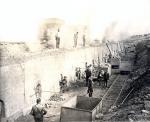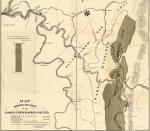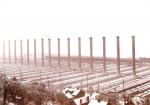![header=[Marker Text] body=[The bee-hive ovens nearby are typical of the region. Coke was first made from coal near Connellsville in this type oven about 1840. Since 1870 use of coke has been vital to steel making.] sign](http://explorepahistory.com/kora/files/1/10/1-A-233-139-ExplorePAHistory-a0h6q9-a_450.jpg)
Mouse over for marker text
Name:
Coke Ovens [Steel]
Region:
Laurel Highlands/Southern Alleghenies
County:
Fayette
Marker Location:
PA 51 just W of Perryopolis
Dedication Date:
December 10, 1946
Behind the Marker
For fifty years, Pennsylvania's steel industry depended to an amazing extent on a skinny strip of land, scarcely two or three miles wide, running some fifty miles through Westmoreland and Fayette counties in southwestern Pennsylvania. Here, a seven-foot-thick seam of high-quality coal poked up its head, ready to be carted away and baked into coke, a valuable industrial fuel.
At its peak in 1913, the Connellsville district's 38,000 ovens provided fully half the entire nation's supply of metallurgical coke. It took 2,000 railcars each day to haul it away. Most of the coke was used in blast furnaces to smelt iron ore into molten pig iron, the raw material for steel.
Prior to the 1840s, this region of family farms also boasted a thriving charcoal-based iron industry. Nearby Brownsville, on the Monongahela river, was a shipping point for the iron products made at the pioneering Alliance Furnace and about twenty other area furnaces and forges. About the same time that the iron plantations had burned through the trees that provided their charcoal, the region developed a serious coke industry.
Alliance Furnace and about twenty other area furnaces and forges. About the same time that the iron plantations had burned through the trees that provided their charcoal, the region developed a serious coke industry.
"Mining here requires no outlay whatsoever . . . since the coal crops out on the flanks of the hills and the banks of the rivers," effused a local chamber of commerce in the mid-1880s. In ten hours" hard work, a man with a boy helper could cut and load ten tons of coal, and sell it for $2.50. The real profits were made by baking that coal into coke: ten tons of coke sold for $14.00 or more. In the early years coke was made just like charcoal; that is, by covering it with clay or sod, and firing it a week or more.
In 1841 a partnership of two carpenters and a stonemason erected the first proper beehive ovens near Sedgwick Station (close to the Hickman Run at the Youghiogheny River). The next year the Cochran brothers turned a nice profit with the same ovens, when they shipped 1,300 bushels to Cincinnati. By 1855, when the railroad first arrived, there were twenty-six ovens. Just two decades later, more than 3,500 local coke ovens shipped out nearly a million tons each year.
The classic beehive oven, often built in single "banks" along a hill or in double "blocks," was around twelve feet in diameter and five to seven feet tall. Workers dumped coal in the top through a "trunnel" to form a layer two feet thick, and sealed the openings with brick, loam, or clay. Heat from the previous charge ignited the coking process, which continued for two or three days.
A chemical cocktail of ammonia, tar, phenols, and choking clouds of smoke went straight into the air. When complete, coke workers opened the oven's door, sprayed the red-hot mass with water, then raked the smoking, steaming coke into railroad cars. Coke work required "little handicraft skill or trained intelligence," and the appalling conditions attracted only "multitudes of newly arrived immigrants . . . huddled - inert, stolid, half-enslaved." A series of bitter labor disputes culminated with the Morewood Massacre in 1891.
Morewood Massacre in 1891.
Connellsville's beehive ovens propelled Henry Clay Frick to leadership of the American steel industry. Frick entered the coke industry in the 1870s, and within a decade was shipping coke as far as Salt Lake City, Utah, and Syracuse, New York. Frick's coke empire grabbed the attention of Pittsburgh steelmaker
Henry Clay Frick to leadership of the American steel industry. Frick entered the coke industry in the 1870s, and within a decade was shipping coke as far as Salt Lake City, Utah, and Syracuse, New York. Frick's coke empire grabbed the attention of Pittsburgh steelmaker  Andrew Carnegie beginning one of the great sagas of American industry.
Andrew Carnegie beginning one of the great sagas of American industry.
Although they made a top-quality fuel, beehive ovens poisoned the surrounding landscape. After 1900, the serious environmental damage of beehive coking attracted national notice, even though the damage had plagued the district for decades. "The smoke and gas from some ovens destroy all vegetation around the small mining communities," noted W. J. Lauck of the U.S. Immigration Commission in 1911. Passing through the region on train, University of Wisconsin president Charles van Hise saw "long rows of beehive ovens from which flame is bursting and dense clouds of smoke issuing, making the sky dark. By night the scene is rendered indescribably vivid by these numerous burning pits. The beehive ovens make the entire region of coke manufacture one of dulled sky, cheerless and unhealthful."
The "original" Connellsville district was a narrow strip that stretched from Latrobe in the north, through Mount Pleasant, Dawson, Connellsville, and to just south of Uniontown. The "lower" Connellsville district, opened up mostly after 1900, ranged between the Youghiogheny and Monongahela rivers, with Perryopolis at its north edge and New Geneva at its south. Once the coke from the new district proved its worth, Fayette Country, as a local historian put it, "went ‘coal crazy"! Farms that had been considered only heirlooms of dead fathers and grandfathers suddenly blossomed into gold."
Connellsville slipped from the national stage around 1920. Concerns about the toxic cloud that issued from beehive ovens led American coke makers, at long last, to adopt byproduct ovens. Used in Europe extensively for decades, byproduct ovens recovered valuable ammonia, gases, and coal tars - raw materials that powered the German synthetic chemicals industry. More complex than the beehive ovens, byproduct ovens were relocated to riverside sites. Clairton, Midland, Aliquippa, Youngstown, and Pittsburgh itself became the regional centers of byproduct coke. Moreover, coal from Kentucky and West Virginia proved especially well adapted to the new technology.
In 1910 beehive ovens made more than 80 percent of the nation's coke. Two decades later their share was less than 6 percent. Today the remains of coke ovens still dot the Pennsylvania countryside. You can hike past a mile of abandoned beehive coke ovens on the Yough River Trail, with trailheads at Dawson and Connellsville.
At its peak in 1913, the Connellsville district's 38,000 ovens provided fully half the entire nation's supply of metallurgical coke. It took 2,000 railcars each day to haul it away. Most of the coke was used in blast furnaces to smelt iron ore into molten pig iron, the raw material for steel.
Prior to the 1840s, this region of family farms also boasted a thriving charcoal-based iron industry. Nearby Brownsville, on the Monongahela river, was a shipping point for the iron products made at the pioneering
"Mining here requires no outlay whatsoever . . . since the coal crops out on the flanks of the hills and the banks of the rivers," effused a local chamber of commerce in the mid-1880s. In ten hours" hard work, a man with a boy helper could cut and load ten tons of coal, and sell it for $2.50. The real profits were made by baking that coal into coke: ten tons of coke sold for $14.00 or more. In the early years coke was made just like charcoal; that is, by covering it with clay or sod, and firing it a week or more.
In 1841 a partnership of two carpenters and a stonemason erected the first proper beehive ovens near Sedgwick Station (close to the Hickman Run at the Youghiogheny River). The next year the Cochran brothers turned a nice profit with the same ovens, when they shipped 1,300 bushels to Cincinnati. By 1855, when the railroad first arrived, there were twenty-six ovens. Just two decades later, more than 3,500 local coke ovens shipped out nearly a million tons each year.
The classic beehive oven, often built in single "banks" along a hill or in double "blocks," was around twelve feet in diameter and five to seven feet tall. Workers dumped coal in the top through a "trunnel" to form a layer two feet thick, and sealed the openings with brick, loam, or clay. Heat from the previous charge ignited the coking process, which continued for two or three days.
A chemical cocktail of ammonia, tar, phenols, and choking clouds of smoke went straight into the air. When complete, coke workers opened the oven's door, sprayed the red-hot mass with water, then raked the smoking, steaming coke into railroad cars. Coke work required "little handicraft skill or trained intelligence," and the appalling conditions attracted only "multitudes of newly arrived immigrants . . . huddled - inert, stolid, half-enslaved." A series of bitter labor disputes culminated with the
Connellsville's beehive ovens propelled
Although they made a top-quality fuel, beehive ovens poisoned the surrounding landscape. After 1900, the serious environmental damage of beehive coking attracted national notice, even though the damage had plagued the district for decades. "The smoke and gas from some ovens destroy all vegetation around the small mining communities," noted W. J. Lauck of the U.S. Immigration Commission in 1911. Passing through the region on train, University of Wisconsin president Charles van Hise saw "long rows of beehive ovens from which flame is bursting and dense clouds of smoke issuing, making the sky dark. By night the scene is rendered indescribably vivid by these numerous burning pits. The beehive ovens make the entire region of coke manufacture one of dulled sky, cheerless and unhealthful."
The "original" Connellsville district was a narrow strip that stretched from Latrobe in the north, through Mount Pleasant, Dawson, Connellsville, and to just south of Uniontown. The "lower" Connellsville district, opened up mostly after 1900, ranged between the Youghiogheny and Monongahela rivers, with Perryopolis at its north edge and New Geneva at its south. Once the coke from the new district proved its worth, Fayette Country, as a local historian put it, "went ‘coal crazy"! Farms that had been considered only heirlooms of dead fathers and grandfathers suddenly blossomed into gold."
Connellsville slipped from the national stage around 1920. Concerns about the toxic cloud that issued from beehive ovens led American coke makers, at long last, to adopt byproduct ovens. Used in Europe extensively for decades, byproduct ovens recovered valuable ammonia, gases, and coal tars - raw materials that powered the German synthetic chemicals industry. More complex than the beehive ovens, byproduct ovens were relocated to riverside sites. Clairton, Midland, Aliquippa, Youngstown, and Pittsburgh itself became the regional centers of byproduct coke. Moreover, coal from Kentucky and West Virginia proved especially well adapted to the new technology.
In 1910 beehive ovens made more than 80 percent of the nation's coke. Two decades later their share was less than 6 percent. Today the remains of coke ovens still dot the Pennsylvania countryside. You can hike past a mile of abandoned beehive coke ovens on the Yough River Trail, with trailheads at Dawson and Connellsville.








